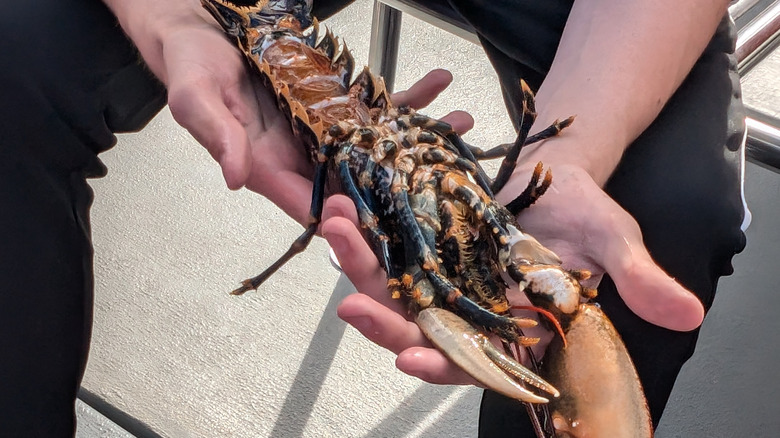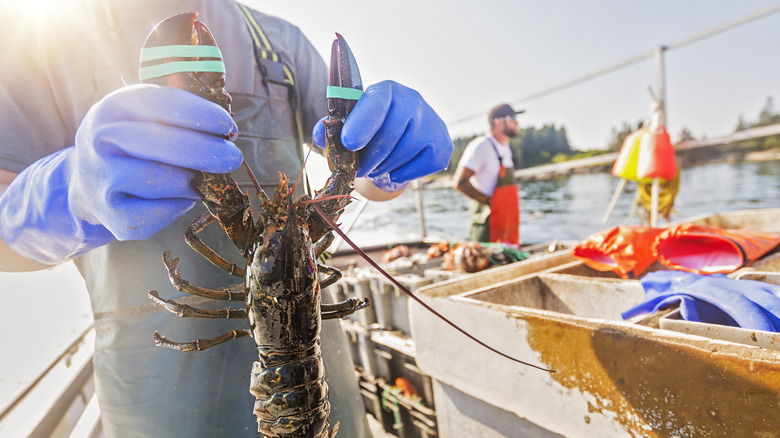Get The Freshest Lobster Possible By Avoiding Ones That Look Like This
For most folks, lobster is a rare treat — so it's hard to know what to look for when you want a fresh one. But Mark Murrell picks out prime lobsters for a living, and he gave The Takeout some advice. Murrell is founder, owner, and Chief Curator of Get Maine Lobster, a site that ships live Maine lobsters across the United States. He's also an advisor to the Maine Lobster Marketing Collaborative.
Unless you're buying frozen, you want your lobsters not only live, but also lively. "When selecting a live lobster, you want to look for spryness," says Murrell. Slow, sluggish lobsters might be sick or close to death. Pick one up by the back of the head and see how it responds. According to Murrell, "It should be able to hold up its claws and curl its tail."
What if the costly crustacean looks limp and lifeless by the time it gets to the kitchen? Murrell says you should still give it a shot. "If a lobster is not moving and you suspect it might be dead, cook it in a separate pot, then check the meat consistency," he says. "If it's firm, it is good to eat. If the meat is crumbly, it is bad."
But why is it so important to buy live lobsters anyway? Brace yourself — it's gory. Lobsters use enzymes in their digestive tract to break down food. As soon as a lobster dies, the enzymes start attacking its flesh. You'll get mushy meat within a few hours.
Does color matter?
If you're a total lobster newbie, you might head to the market expecting to find bright red lobsters for sale. You'll probably be disappointed. "Live lobsters are most often a greenish brown color," Murrell says. Typically, lobsters only get their fire-engine hue after they've been cooked; when the lobster is exposed to heat, the other pigments fade away, leaving only the bright red hue.
But Murrell adds that a greenish brown color isn't the only possibility. "Their shells can also be blue, orange, white, red, and half one, half another color," he explains. "The shell color doesn't have any impact on the freshness or quality of the meat." That said, rainbow hues aren't exactly common: If you do manage to find that rare, bright red-orange lobster live, it's a one in 10 million catch.
However, color can cue you in on the animal's age. "New shell lobsters tend to be bright red on the underside of the claws, while old shell lobsters tend to be darker and scuffed up," he says. "Both have delicious meat, although new shell tends to be sweeter while old shells have a brinier flavor." He adds that other minor scuffs and injuries are worth overlooking. "Antennae are often damaged when lobsters are in traps and tanks, and don't impact the freshness of the lobster," he explains.
Does size matter?
According to Murrell, size doesn't matter much. "Lobsters can be fresh and delicious at any size as long as they are cooked properly," he explains. While some lobster lovers say that smaller lobsters are sweeter, others argue that the difference is negligible. However, taste isn't the only consideration. Large lobsters have more meat, which makes them easier to shell. However, it can also be difficult to get the lobster to cook all the way through. It's easy to end up overcooking the meat, which isn't what you want (though it is possible to salvage overcooked lobster).
Budget matters, too. Larger lobsters tend to be pricier — at least, if you're buying them from Maine. "In Maine, it is legal to harvest lobsters between about one to four and a half pounds," says Murrell. The logic? Larger, more mature lobsters produce more eggs, so keeping them in the oceans keeps populations strong. Since there aren't as many large lobsters to go around, they tend to be costly. Not all states put an upper limit on the size of lobsters, though. If you're buying lobster in another state, the larger ones might be comparatively priced — or even cheaper.


